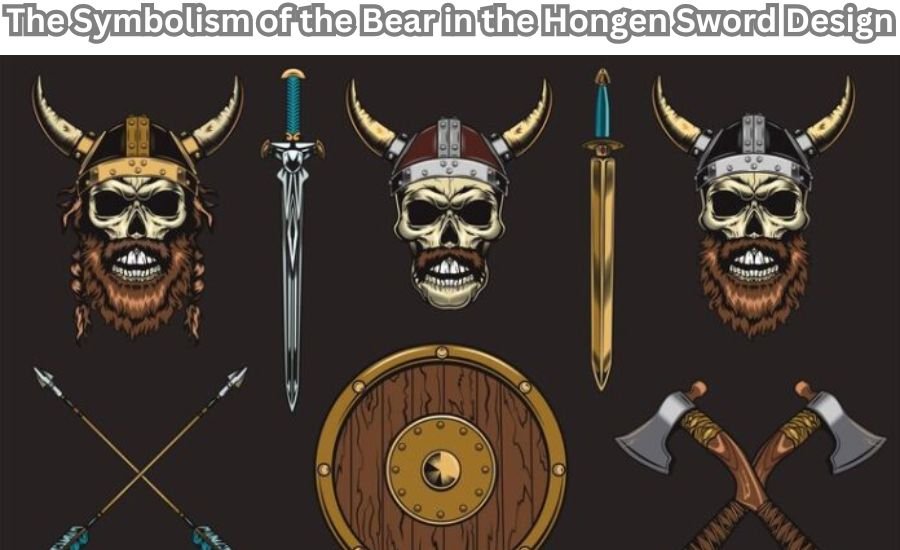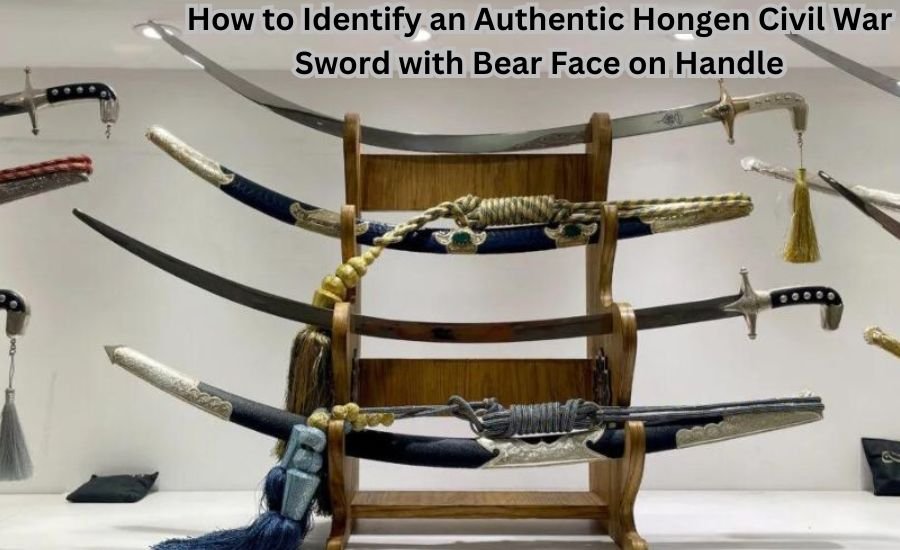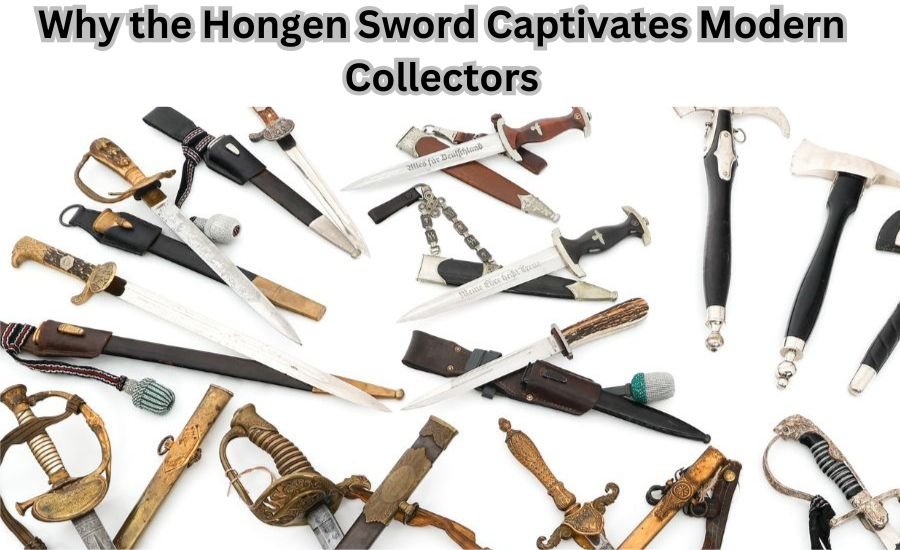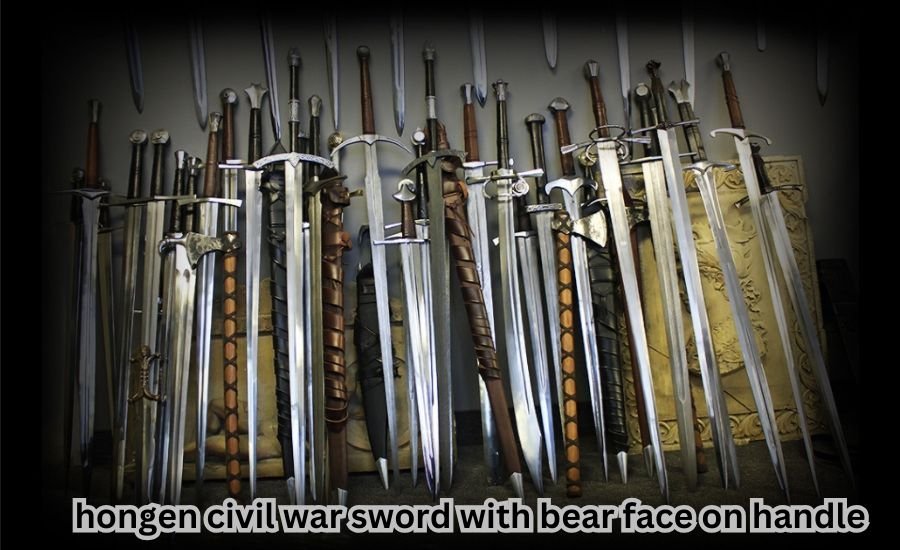The Hongen Civil War sword with bear face on handle is more than just a historical artifact; it is a symbol of strength, craftsmanship, and valor from one of the most turbulent times in American history. This remarkable sword, distinguished by its bear face handle, stands out as a relic of personal courage and artistic mastery, making it a treasured piece of the Civil War era.
In this blog post, we will explore the fascinating history behind the Hongen Civil War sword with bear face on handle, its significance during the Civil War, and why it remains a coveted collector’s item today. From the expert craftsmanship of Jeremiah Hongen to the symbolic meaning of the bear, this sword offers a unique glimpse into the culture and spirit of the soldiers who wielded it.
The Craftsmanship Behind the Hongen Civil War Sword
Crafting the Hongen Civil War sword with bear face on handle was no easy task. Each sword was the result of weeks of work by skilled craftsmen, who combined European techniques with American ingenuity. The blade was forged from high-quality steel, often using a process that involved folding the metal repeatedly to create intricate patterns. This method not only strengthened the sword but also gave it a unique appearance that set it apart from other weapons of the time.
The bear face handle was equally impressive. Made from brass or bronze, it featured lifelike details, including inlaid silver for the bear’s eyes and engraved fur patterns. These details made each sword a personal item for the soldiers, who often viewed it as a badge of honor. The handle was designed to fit comfortably in the hand, allowing soldiers to wield the sword with confidence in battle. The balance between beauty and practicality made the Hongen sword a prized possession for many.
The Role of the Hongen Sword in the American Civil War
The Hongen Civil War sword with bear face on handle was more than just a weapon; it was a symbol of leadership and authority. Officers who carried the sword were often seen as brave and strong, embodying the spirit of the bear that the handle represented. The sword played a key role in several important battles, including the Battle of Gettysburg, where Union officers used their Hongen swords in close combat.
Many soldiers believed that the bear face handle gave them strength in battle, drawing from the animal’s reputation for courage and resilience. The sword was not just a tool for fighting; it became a symbol of the soldiers’ personal connection to the land they were defending. This deep sense of identity made the Hongen sword a cherished item for those who fought with it.
Why the Hongen Sword with Bear Face on Handle is Still Valuable Today
Today, the Hongen Civil War sword with bear face on handle is a highly sought-after collector’s item. Its historical significance, combined with its masterful craftsmanship, makes it a valuable piece of Americana. Collectors look for the Hongen maker’s mark on the blade and the detailed craftsmanship of the bear face handle to authenticate these swords. Owning an original Hongen sword is considered a great honor for many collectors and history enthusiasts.
The value of the Hongen Civil War sword with bear face on handle continues to grow, with some swords selling for tens of thousands of dollars at auctions. This high demand reflects the ongoing fascination with the American Civil War and the unique cultural artifacts it produced. For those interested in both history and craftsmanship, the Hongen sword offers a tangible connection to a pivotal time in American history.
The Symbolism of the Bear in the Hongen Sword Design

The Hongen Civil War sword with bear face on handle was not just designed for combat but also for symbolism. The bear, a powerful and majestic creature, represented key traits such as strength, courage, and resilience—qualities that were highly valued by the soldiers of the Civil War. The bear is often associated with protection and leadership, making it a fitting symbol for officers who carried the Hongen sword.
The choice of a bear as the design for the handle was deliberate. Jeremiah Hongen, the sword’s creator, drew inspiration from the American wilderness, where the bear was seen as a king of the wild. The sword served as a reminder to soldiers of the land they were fighting for and the values they upheld. The symbolism behind the bear was so strong that many soldiers believed it brought them luck and power on the battlefield.
Each sword was unique, with some officers even requesting custom engravings on their bear handles to reflect their personal connection to the weapon. This attention to personal details made the Hongen sword more than just a military tool—it became a personal keepsake and symbol of honor for the soldiers.
Notable Figures Who Wielded the Hongen Civil War Sword
Throughout the American Civil War, several high-ranking officers were known to carry the Hongen Civil War sword with bear face on handle. One of the most famous was Union General Joshua Chamberlain, who led his troops to victory during the Battle of Gettysburg. Chamberlain was known for his leadership and bravery, and the bear head sword became a symbol of his personal strength and courage.
Confederate General J.E.B. Stuart was another notable figure who carried a Hongen sword. His cavalry raids became legendary during the war, and his men often spoke of the bear head handle as a source of inspiration and pride. Stuart’s sword became a symbol of his daring tactics and the fearless nature of his command.
These stories highlight the personal connection that many officers had with their Hongen Civil War sword with bear face on handle. It wasn’t just a weapon for them; it was a part of their identity on the battlefield. Many soldiers cherished their swords long after the war ended, passing them down as family heirlooms to honor their legacy.
The Legacy of the Hongen Civil War Sword in Modern Times
Even today, the Hongen Civil War sword with bear face on handle continues to be a symbol of craftsmanship and history. Collectors and historians alike seek out these swords, not only for their historical significance but for the incredible artistry that went into their creation. Museums often display Hongen swords as part of their Civil War exhibits, allowing visitors to connect with the history in a tangible way.
The enduring appeal of the Hongen Civil War sword with bear face on handle lies in its combination of functionality and symbolism. It represents the American spirit of resilience and determination that defined the Civil War era. For collectors, owning a Hongen sword is more than just possessing a piece of history—it’s about connecting with a story of bravery and craftsmanship that continues to resonate.
Collectors who own an authentic Hongen sword are often dedicated to preserving it for future generations. This dedication to preservation reflects the sword’s importance, not only as a military artifact but as a cultural touchstone that tells the story of America’s past.
How to Identify an Authentic Hongen Civil War Sword with Bear Face on Handle

Identifying an authentic Hongen Civil War sword with bear face on handle requires careful examination of several key features. First, the blade should bear the Hongen maker’s mark, usually found near the hilt. This mark signifies that the sword was crafted by Jeremiah Hongen’s workshop and guarantees its authenticity. Without this mark, it’s unlikely that the sword is a genuine Hongen piece.
Next, examine the bear face handle for its level of detail. Authentic Hongen swords feature finely crafted bear heads with textured fur, lifelike eyes, and carefully sculpted expressions. The inlaid silver for the bear’s eyes is another hallmark of genuine Hongen craftsmanship, giving the bear a strikingly realistic appearance.
Finally, check the blade itself for the Damascus steel pattern, a feature that sets Hongen swords apart from others. The intricate layers of steel, created by repeated folding and hammering, should be visible on the blade. This process gives the sword its distinctive strength and flexibility, making it both beautiful and practical for use in battle.
By following these steps, collectors can ensure they are purchasing a real piece of Civil War history. Authentic Hongen swords are highly valued, with some examples selling for significant sums at auctions, reflecting their rarity and historical importance.
Preserving the Hongen Civil War Sword: Essential Tips for Collectors
For collectors of the Hongen Civil War sword with bear face on handle, proper preservation is crucial to maintain both its historical and monetary value. Storing the sword in a climate-controlled environment is key to preventing rust, as temperature and humidity fluctuations can damage the metal over time. Regularly oiling the blade will help keep it sharp and protect it from corrosion. When handling the sword, it’s recommended to use gloves to prevent oils from your skin from tarnishing the metal. If the sword has intricate engravings or inlays, extra care should be taken to avoid scratching or damaging these delicate features. For display purposes, a glass case can be used to protect the sword from dust while allowing it to be admired. Proper preservation ensures that this valuable artifact remains intact for generations to come.
The Historical Role of the Hongen Sword in American Warfare
The Hongen Civil War sword with bear face on handle played a significant role in the leadership structure of the Civil War. Though firearms were prevalent, officers continued to carry swords as symbols of authority and command. The sword was often used during cavalry charges, where officers on horseback led their troops into close combat. The bear face handle was a unique feature that set the Hongen sword apart, symbolizing strength and fearlessness. Officers carrying these swords were seen as figures of bravery, embodying the bear’s ferocity and resilience. The sword was not just a tool of war but a symbol of leadership that inspired soldiers. Although the use of swords declined in modern warfare, the Hongen sword remains an enduring reminder of the courage and strategy displayed during the Civil War.
Cultural Significance of the Bear in the Hongen Sword Design
The bear symbol in the Hongen Civil War sword with bear face on handle held deep cultural meaning, representing qualities like strength, protection, and bravery. For the soldiers, the bear connected them to the wild, untamed American frontier, a symbol of the land they were fighting to protect. The bear’s courage in defending its territory mirrored the soldiers’ own role in the conflict, making the sword more than just a weapon—it was a source of inspiration. In Native American cultures, the bear is also seen as a wise and protective creature, which added a layer of reverence to the sword’s design. This powerful symbol made the Hongen sword a personal and cultural icon for those who carried it into battle. Its blend of artistic design and meaningful symbolism continues to captivate collectors and historians alike.
Why the Hongen Sword Captivates Modern Collectors

The Hongen Civil War sword with bear face on handle remains a highly sought-after item among collectors for several reasons. Its rarity, historical significance, and intricate craftsmanship make it a prized possession. Each sword carries its own story, often with records of the battles it was used in or the officers who wielded it. These personal connections add immense value to each sword, making it more than just a historical artifact. Collectors look for specific details, such as the Hongen maker’s mark and the bear face design, to authenticate the sword and ensure its originality. Due to its limited availability, well-preserved examples can fetch high prices at auctions. For collectors, owning a Hongen sword is not only a financial investment but also a way to preserve and honor a piece of American history.
Conclusion
The Hongen Civil War sword with bear face on handle is more than just a weapon; it is a symbol of bravery and history. This unique sword connects us to the past, reminding us of the soldiers who fought during the Civil War. Each sword tells a story of strength, courage, and the struggles that shaped our nation. Owning a Hongen sword is like having a piece of history that reflects the spirit of those who fought for their beliefs.
In today’s world, the legacy of the Hongen Civil War sword with bear face on handle continues to inspire collectors and history lovers. These swords are highly valued not only for their beauty but also for the powerful stories they carry. By learning about these artifacts, we keep the memory of the brave soldiers alive. The Hongen sword serves as a reminder that even in times of conflict, courage and craftsmanship can shine brightly.
Get the Latest Updates On Knowlegdera
FAQS
Q: What is the Hongen Civil War sword with bear face on handle?
A: The Hongen Civil War sword is a unique weapon crafted during the American Civil War, featuring a distinctive bear face as its handle. It symbolizes bravery and craftsmanship from that era.
Q: Who created the Hongen Civil War sword?
A: The sword was created by Jeremiah Hongen, a talented swordsmith from Pennsylvania, who aimed to combine artistic design with functional weaponry.
Q: What does the bear face symbolize on the sword?
A: The bear face represents strength, courage, and resilience, reflecting the qualities soldiers needed during the Civil War.
Q: How long is the Hongen sword?
A: The blade of the Hongen sword typically measures between 32 to 36 inches in length, making it effective for combat.
Q: Why is the Hongen sword valuable to collectors?
A: The sword is valuable due to its unique design, historical significance, and the craftsmanship that went into making each piece.
Q: What should I look for when authenticating a Hongen sword?
A: To authenticate a Hongen sword, check for the maker’s mark on the blade, detailed craftsmanship of the bear head, and the distinct Damascus pattern on the steel.
Q: How can I preserve a Hongen Civil War sword?
A: To preserve the sword, keep it in climate-controlled storage, regularly oil the blade to prevent rust, and handle it carefully to maintain its engravings and details.
